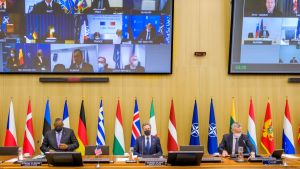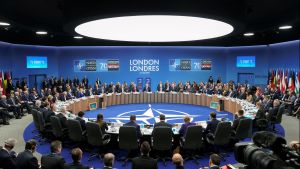US Allies vs. Partners—What's the Difference?
 Play Video
Play Video
America’s relationship with our allies has played a pivotal role in how the US has responded to the Russian invasion of Ukraine. But what are allies, and how do they differ from partners? Here’s what you should know.
America’s allies and partners are crucial to US foreign policy, as demonstrated by how the US has responded to the Russian invasion of Ukraine. But what are allies? Why does America have them? And how do they differ from partners?
While the terms are often used interchangeably by politicians and the press, they aren’t the same.
To start, an alliance formally refers to a defense treaty between countries, meant to deter attacks from others. An attack on a treaty ally can be considered an attack on one’s own soil.
Former President George W. Bush: Together, we're building a very strong coalition against terror, and NATO is the cornerstone of that coalition.
The US has formal alliances with 51 countries, including 29 NATO allies. NATO was formed at the beginning of the Cold War to deter attacks and defend Western European countries from the Soviet Union. Today, it serves the same purpose against Russia.
Treaties don’t dictate exactly how the US would come to an ally’s defense. Our response depends on the context when a treaty is invoked. But alliances are only effective if potential aggressors believe that the US will follow through on its commitments. If the US failed to, it would lose credibility.
Alliances offer many benefits but can also be risky. If we form an alliance with a country that has territorial disputes, then that ally may feel emboldened to act more aggressively, which may not be in America's interests.
Partnerships can also be based on shared security interests but differ from alliances in that there isn’t a formal commitment to mutual defense. Our commitments to partners are more ambiguous and thus easier to change. Some US partnerships involve sharing intelligence and military aid, which we provide because this assistance may ultimately support our security interests.
The utility of our partnerships can vary, as do the justifications. Take the US partnership with Saudi Arabia. It primarily aims to keep oil prices stable. However, Saudi Arabia has not used its influence to do so. Under this partnership, both countries’ commitments are ambiguous.
Many in Congress are urging the administration to end the relationship with Saudi Arabia for that reason. The president has the authority to do so should he choose.
Both partnerships and alliances play a significant role in the issues dominating the headlines today. Understanding what those relationships mean helps us understand what events in the news might mean for us.


Related Content
 Public Opinion
Public Opinion
The Biden administration emphasizes strengthening ties with America's global allies and partners. Which countries do Americans view as their allies—and adversaries?
 Public Opinion
Public Opinion
A new experiment by researchers from the University of Illinois at Springfield, the University of Chicago, and the Chicago Council on Global Affairs finds that policy experts care about formal alliances. But even alliance relationships have limits.
 Defense and Security
Defense and Security
Mira Rapp-Hooper joins Ivo Daalder on Deep Dish for a discussion about the state of US alliances at a moment when new concerns are flaring up.
